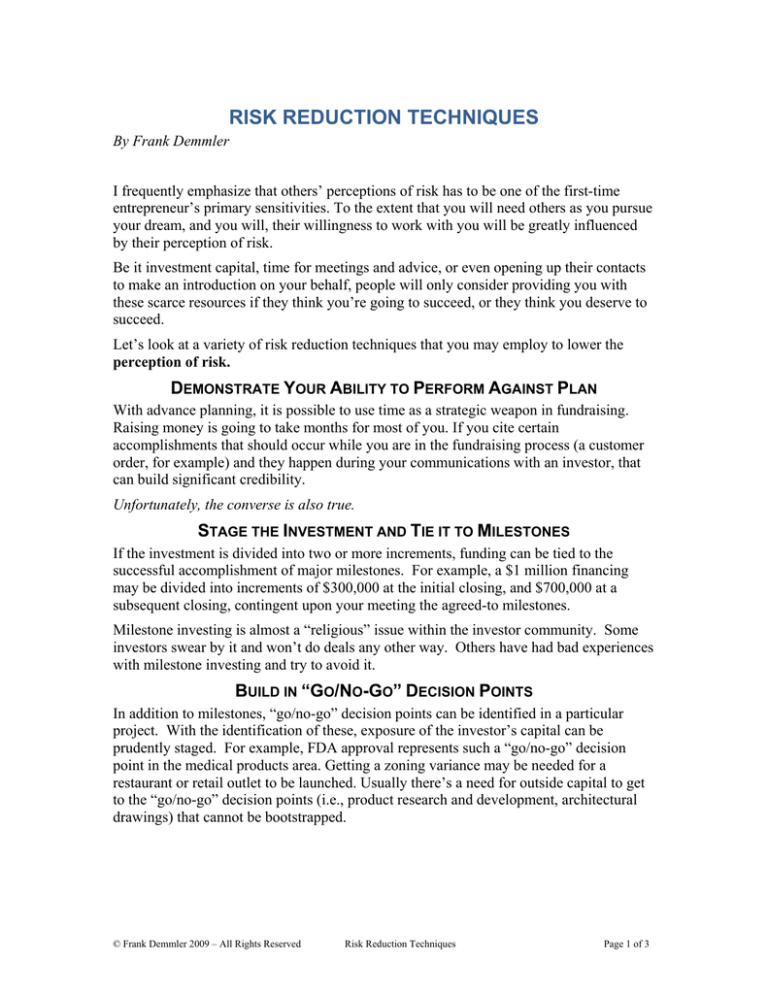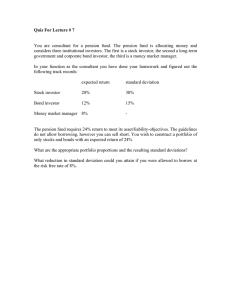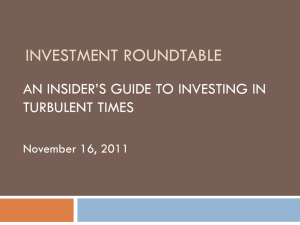
RISK REDUCTION TECHNIQUES
By Frank Demmler
I frequently emphasize that others’ perceptions of risk has to be one of the first-time
entrepreneur’s primary sensitivities. To the extent that you will need others as you pursue
your dream, and you will, their willingness to work with you will be greatly influenced
by their perception of risk.
Be it investment capital, time for meetings and advice, or even opening up their contacts
to make an introduction on your behalf, people will only consider providing you with
these scarce resources if they think you’re going to succeed, or they think you deserve to
succeed.
Let’s look at a variety of risk reduction techniques that you may employ to lower the
perception of risk.
DEMONSTRATE YOUR ABILITY TO PERFORM AGAINST PLAN
With advance planning, it is possible to use time as a strategic weapon in fundraising.
Raising money is going to take months for most of you. If you cite certain
accomplishments that should occur while you are in the fundraising process (a customer
order, for example) and they happen during your communications with an investor, that
can build significant credibility.
Unfortunately, the converse is also true.
STAGE THE INVESTMENT AND TIE IT TO MILESTONES
If the investment is divided into two or more increments, funding can be tied to the
successful accomplishment of major milestones. For example, a $1 million financing
may be divided into increments of $300,000 at the initial closing, and $700,000 at a
subsequent closing, contingent upon your meeting the agreed-to milestones.
Milestone investing is almost a “religious” issue within the investor community. Some
investors swear by it and won’t do deals any other way. Others have had bad experiences
with milestone investing and try to avoid it.
BUILD IN “GO/NO-GO” DECISION POINTS
In addition to milestones, “go/no-go” decision points can be identified in a particular
project. With the identification of these, exposure of the investor’s capital can be
prudently staged. For example, FDA approval represents such a “go/no-go” decision
point in the medical products area. Getting a zoning variance may be needed for a
restaurant or retail outlet to be launched. Usually there’s a need for outside capital to get
to the “go/no-go” decision points (i.e., product research and development, architectural
drawings) that cannot be bootstrapped.
© Frank Demmler 2009 – All Rights Reserved
Risk Reduction Techniques
Page 1 of 3
USE CREDIBLE INTERMEDIARIES
Another risk reduction technique involves using intermediaries who have independent
credibility.
If you use somebody to introduce you to the investor, the quality of the person who
provides the introduction says a lot about you. For example, the CEO of a successful
company in which your targeted investor has placed money would be a very powerful
intermediary for these purposes.
Similarly, using professionals (often called investment bankers) who have successfully
raised money for similar businesses in the past, can be an effective strategy. They
already have a network of investors who will often invest in particular situations based
primarily upon the recommendation of the financial professional.
Before moving on, there are two important points related to the use of professional
intermediaries.
•
You must ask the question, “May I please have the names and contact information
for three of my peers for whom you have provided theses services?”
•
Successful professional fundraisers often use an upfront fee to screen prospective
clients. Therefore, if the references check out well, you should not reject an
upfront fee out of hand.
This latter point is probably contrary to a lot of the advice you are likely to receive.
First, unscrupulous people do exist who prey on naïve first-time entrepreneurs. They will
put on an impressive show and request a retainer for their services. Don’t fall for that.
I remember a time in the late 1990s that a firm from New York City used the Pittsburgh
Technology Council’s membership directory as a source of cold call leads. They dangled
the prospect of raising money before the CEOs of these companies, and cautioned these
CEOs not to share the overture with anyone else because this firm had chosen their
company based upon some unnamed recommendation. In several instances, CEOs and
their teams went to New York to pitch their deals (at their own expense) after which the
supposed fundraiser extolled the team’s virtues and expressed excitement about working
with them. For a modest check (I think the range was $10,000 to $25,000, depending
upon what they thought they could get) and a signature on an engagement letter (that
relieves them of any responsibility or liability, although that won’t be obvious to you),
they were ready to lead the CEO to the Holy Grail. I know of at least three companies
that got bamboozled this way.
Still, if you check out the investment advisor with others for whom he has successfully
raised money, then think long and hard before rejecting him if that’s the only reason for
doing so. Your goal is to raise money for your business and if this person can materially
improve your chances of doing so, especially as compared to other fund raisers who don’t
charge an upfront fee, don’t be “penny wise, but pound foolish.”
© Frank Demmler 2009 – All Rights Reserved
Risk Reduction Techniques
Page 2 of 3
HALO EFFECT OF ADVISORS
Just as intermediaries use their credibility to attract investors, those people that you can
identify as being involved in your company as mentors, advisors or board members, can
also be very effective in lowering risk perceptions.
There is one caution, however. If these individuals are thought to have a high net worth,
but have not invested in the company, a “red flag” will be raised with many investors
and this may work to your disadvantage.
THIRD PARTY CONFIRMATION OR ENDORSEMENT
Quite often an investor is going to be skeptical about the claims an entrepreneur makes.
Therefore, independent sources, such as a trade journal article or an independent market
study, that confirm critical elements of a business proposal can be very effective tools in
building credibility and investor interest.
RELEVANT ANALOGS
Comparing your business to one that is a known success can be a very effective risk
reduction technique and can help you describe your business in easily understood terms.
•
The Wendy’s of hot dogs.
•
The Dell Computer of home theater receivers.
I’m hoping that at least one of these created an immediate impression in your mind. It
didn’t take pages and pages of text to do so, just a well-chosen phrase. What analogy
works for your business?
ADVICE TO THE ENTREPRENEUR
•
Always be aware of and sensitive to how others perceive the risk of your
business.
•
Take advantage of low-cost, or no-cost, ways to reduce the perceived risk.
•
Be cautious and careful when using outside professionals with whom you haven’t
worked before.
?
•
You must ask the question, “May I please have the names and contact
information for three of my peers for whom you have provided theses
services?”
Surround yourself with professionals, mentors, and advisors who can help you
level the playing field.
© Frank Demmler 2009 – All Rights Reserved
Risk Reduction Techniques
Page 3 of 3





